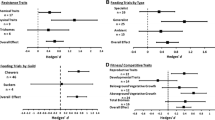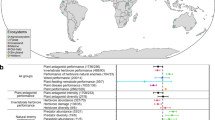Abstract
After two decades of meta-analyses on plant traits, we can now look for global emergent patterns in plant evolutionary ecology. Hundreds of meta-analyses have focused on the effects of specific selection pressures on plant fitness, and the buildup of such results allows us to ask general questions regarding selection pressures and plant responses, a major focus of evolutionary ecology. Plant traits are affected by both abiotic and biotic factors. For example, biotic pressures like herbivory may affect physiological (i.e. secondary defences) and reproductive (i.e. seed predation) traits. Similarly, abiotic pressures such as increased CO2 may affect both plant physiology and reproduction. We tested whether biotic or abiotic selective pressures are more important for plant traits, and if the strength of the response to those pressures depends on the plant trait studied by meta-analyzing published meta-analyses on plant responses. We classify meta-analyses according to the type of response variable studied (fitness and non-fitness traits) and the type of selective pressure examined (biotic or abiotic). Our database showed biases in the meta-analysis literature, for example that the majority of studies are focused on non-fitness traits, i.e. on traits that are not directly related to reproduction or survival, and furthermore, on non-fitness traits under abiotic selection pressures. The meta-meta-analysis showed that the strength of responses to selection depends on the nature of selection (stronger for biotic than for abiotic factors) but, unexpectedly, not on the type of trait under study as previously found. The stronger responses to biotic factors can be explained if biotic selection is more variable in space and time, driven by interactions with other organisms. The relative importance of biotic versus abiotic factors on plant traits has been little studied in the past, and would benefit from more studies and reviews that fill the under-represented combinations of selective pressures and plant traits (i.e. abiotic factors on fitness traits).

Similar content being viewed by others
References
Bailey JK, Schweitzer JA, Úbeda F, Koricheva J, LeRoy CJ, Madritch MD, Rehill BJ, Bangert RK, Fischer DG, Allan GJ, Whitham TG (2009) From genes to ecosystems: a synthesis of the effects of plant genetic factors across levels of organization. Philos T Roy Soc B 364(1523):1607–1616
Barto EK, Rillig MC (2011) Dissemination biases in ecology: effect sizes matter more than quality. Oikos. doi:10.1111/j.1600-0706.2011.19401.x
Becker LA, Oxman AD (2011) Chapter 22: overviews of reviews. In: Higgins JPT, Green S (eds) Cochrane handbook for systematic reviews of interventions version 5.1.0 (updated March 2011). The Cochrane collaboration. Available from http://www.cochrane-handbook.org
Bell G (2010) Fluctuating selection: the perpetual renewal of adaptation in variable environments. Phil Trans R Soc B 365(1537):87–97
Blomberg SP, Garland T, Ives AR (2003) Testing for phylogenetic signal in comparative data: behavioral traits are more labile. Evolution 57:717–745
Caldwell DM, Welton NJ, Ades AE (2010) Mixed treatment comparison analysis provides internally coherent treatment effect estimates based on overviews of reviews and can reveal inconsistency. J Clin Epidemiol 63(8):875–882
Chamberlain SA, Holland JN (2009) Quantitative synthesis of context dependency in ant-plant protection mutualisms. Ecology 90(9):2384–2392
Geber MA, Griffen LR (2003) Inheritance and natural selection on functional traits. Int J Plant Sci 164(3 Suppl.):S21–S42
Grant PR, Grant BR (2002) Unpredictable evolution in a 30-year study of Darwin’s finches. Science 296:707–711
Groenigen KJ, Osenberg CW, Hungate BA (2011) Increased soil emissions of potent greenhouse gases under increased atmospheric CO2. Nature 475:214–216
Gurevitch J, Curtis PS, Jones MH (2001) Meta-analysis in ecology. Adv Ecol Res 32:199–247
Hadfield JD (2010) MCMC methods for multi-response generalised linear mixed models: the MCMCglmm R package. J Stat Sci 33(2):1
Hadfield JD, Nakagawa S (2010) General quantitative genetic methods for comparative biology: phylogenies, taxonomies and multi-trait models for continuous and categorical characters. J Evol Biol 23(3):494–508
Hasselblad V (1998) Meta-analysis of multitreatment studies. Med Decis Making 18(1):37–43
Hereford J, Hansen TF, Houle D (2004) Comparing strengths of directional selection: how strong is strong? Evolution 58(10):2133–2143
Herrera CM, Castellanos MC, Medrano M (2006) Geographical context of floral evolution: towards an improved research programme in floral diversification. In: Harder LD, Barrett SCH (eds) Ecology and evolution of flowers. Oxford University Press, New York, pp 178–294
Higgins JPT, Thompson SG (2002) Quantifying heterogeneity in a meta-analysis. Stat Med 21(11):1539–1558
Higgins JPT, Thompson SG, Deeks JJ, Altman DG (2003) Measuring inconsistency in meta-analyses. Br Med J 327:557–560
Hunter JE, Schmidt FL (2004) Methods of meta-analysis, 2nd edn. Sage, Thousand Oaks
Ioannidis JP (2009) Integration of evidence from multiple meta-analyses: a primer on umbrella reviews, treatment networks and multiple treatments meta-analyses. CMAJ 181(8):488–493
Kingsolver JG, Diamond SE (2011) Phenotypic selection in natural populations: what limits directional selection? Am Nat 177(3):346–357
Kingsolver JG, Hoekstra HE, Hoekstra JM, Berrigan D, Vignieri SN, Hill CE, Hoang A, Gibert P, Beerli P (2001) The strength of phenotypic selection in natural populations. Am Nat 157(3):245–261
Lajeunesse MJ, Forbes MR (2003) Variable reporting and quantitative reviews: a comparison of three meta-analytical techniques. Ecol Lett 6:448–454
Lande R, Arnold SJ (1983) The measurement of selection on correlated characters. Evolution 37:1210–1226
Linhart YB, Grant MC (1996) Evolutionary significance of local genetic differentiation in plants. Annu Rev Ecol Syst 27:237–277
Louthan AM, Kay KM (2011) Comparing the adaptive landscape across trait types: larger QTL effect size in traits under biotic selection. BMC Evol Biol 11:60
Marín-Martínez F, Sánchez-Meca J (2010) Weighting by inverse variance or by sample size in random-effects meta-analysis. Educ Psychol Measur 70:56–73
Merilä J, Sheldon BC (1999) Genetic architecture of fitness and nonfitness traits: empirical patterns and development of ideas. Heredity 83:103–109
Morrissey M, Hadfield J (2012) Directional selection in temporally replicated studies is remarkably consistent. Evolution. doi:10.1111/j.1558-5646.2011.01444.x
Nakagawa S, Cuthill IC (2007) Effect size, confidence interval and statistical significance: a practical guide for biologists. Biol Rev 82(4):591–605
Nakagawa S, Santos ESA (2012) Methodological issues and advances in biological meta-analysis. Evol Ecol. doi:10.1007/s10682-012-9555-5
Rieseberg LH, Widmer A, Arntz AM, Burke JM (2002) Directional selection is the primary cause of phenotypic diversification. Proc Natl Acad Sci USA 99(19):12242–12245
Schluter D (2000) The ecology of adaptive radiation. Oxford series in ecology and evolution. Oxford University Press, New York
Siepielski AM, DiBattista JD, Carlson SM (2009) It’s about time: the temporal dynamics of phenotypic selection in the wild. Ecol Lett 12(11):1261–1276
Thompson JN (2005) The geographic mosaic of coevolution. University of Chicago Press, Chicago
Trager MD, Bhotika S, Hostetler JA, Andrade GV, Rodriguez-Cabal MA, McKeon CS, Osenberg CW, Bolker BM (2010) Benefits for plants in ant-plant protective mutualisms: a meta-analysis. PLoS One 5(12):e14308
Verdú M, Traveset A (2004) Bridging meta-analysis and the comparative method: a test of seed size effect on germination after frugivores’ gut passage. Oecologia 138:414–418
Acknowledgments
We thank J. Sánchez-Meca for comments and discussion on the use of meta-analysis of meta-analyses in ecology and other disciplines, and three reviewers for constructive comments on an earlier version of the manuscript. S. Nakagawa helped with the statistical analyses. This work was developed under the framework of projects VAMPIRO (CGL2008-05289-C02-01) and the European LinkTree project (BiodivERsA, EUI2008-03713). MCC was supported by a JAE-Doc CSIC scholarship.
Author information
Authors and Affiliations
Corresponding author
Electronic supplementary material
Below is the link to the electronic supplementary material.
Rights and permissions
About this article
Cite this article
Castellanos, M.C., Verdú, M. Meta-analysis of meta-analyses in plant evolutionary ecology. Evol Ecol 26, 1187–1196 (2012). https://doi.org/10.1007/s10682-012-9562-6
Received:
Accepted:
Published:
Issue Date:
DOI: https://doi.org/10.1007/s10682-012-9562-6




